1981 German Grand Prix race report
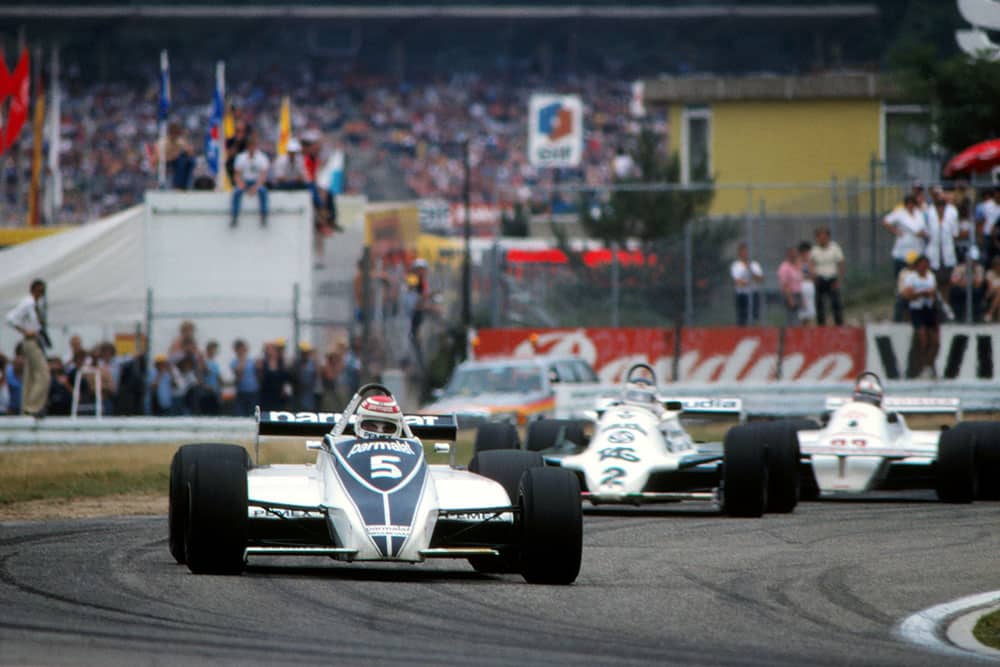
Brabham's Nelson Piquet took his 3rd win of the season
Motorsport Images
Rather Dull
Hockenheimring, August 2nd
After the green and pleasant garden-party atmosphere of the British Grand Prix at Silverstone, with its garden-party result, it was a nasty shock to enter the concrete stadium in which part of the German Grand Prix was going to be enacted. It was like being plucked from a farm deep in the countryside and thrust into a concentration camp, except that the guards were all friendly and smiling, but to get to where the action was in the pits you needed to show your pass nine separate times. Since last year the whole pit complex has been completely rebuilt and a fine job has been made, with ample room for two cars in the depth of each pit, with up-and-over doors at each end, so that when everything is open there is a vast covered area available and with clear panels in the roof and only wire netting between adjacent pits the atmosphere is very light. Each team had more than enough space to keep everything under cover, either from the torrid heat generated in the surrounding concrete grandstands, or from the torrential rain that can hit the Mannheim industrial area of Germany. In addition a new entrance and exit road to the pit lane had been constructed, clearly defined and easy to use, with traffic lights controlling the exit back onto the track after the first corner.
I said in the opening paragraph that the stadium was where part of the German Grand Prix was going to be enacted, because the cars spend about 45 seconds inside the stadium and more than a minute outside it, going away on a long sweeping right hand flat-out curve, through an artificial ess-bend to the tight but very fast long right hander called the Ostkurve that brings them back onto the return straight, more or less parallel to the outward one and also containing an artificial ess-bend halfway along its length. They arrive back in the stadium by a sharp right hander where some desperate overtaking can be done under braking from maximum speed. Ninety per cent of the spectators are contained within the concrete stadium, the rest are scattered along parts of the outward leg and in a grandstand overlooking the Ostkurve, which is situated in a magnificent pine forest. If you were content just to see racing cars and not really know what was going on you could spend a nice time out in the country; if you need to know and see what is happening you have to battle your way into the stadium. The Hockenheimring is not called a Motodrom for nothing.
Qualifying
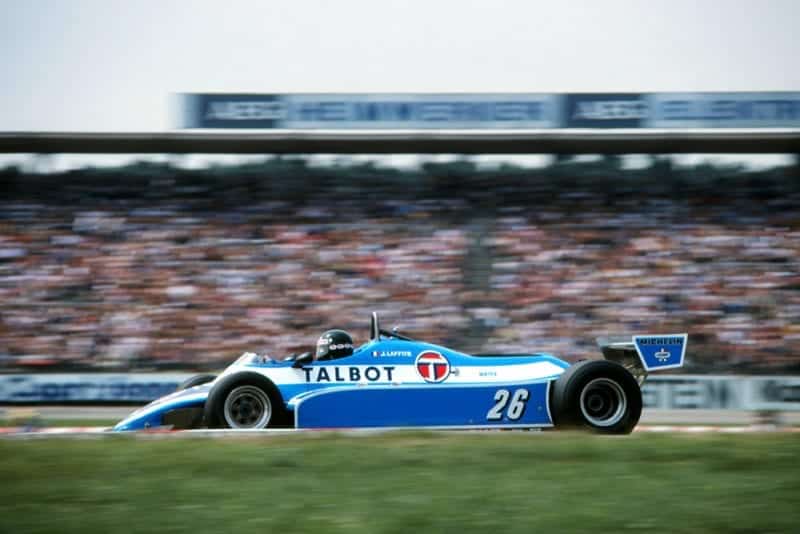
Jacques Laffite qualified 7th for Ligier
Motorsport Images
As is the familiar pattern everyone was ready to go on Friday morning at 10 am, to start the hour-and-a-half of testing time, preparatory to the hour for qualifying in the afternoon, but there was a strange atmosphere of lassitude over the whole scene. Nobody seemed particularly eager and there was no atmosphere of urgency about the place, while the handful of keen spectators huddled in one corner of the vast empty stadium did not impart much sense of occasion. Like the stadium the weather was a bit grey and cool and there were spots of rain in the air which instilled a degree of uncertainty into the proceedings. With cigarette advertising totally banned at sporting events in Germany Team-Lotus, Talbot-Matra, McLaren, and Alfa Romeo were all covered in sticky tape or blank patches which gave an unreal air to the pits and paddock for you felt that one good gust of wind and the awful truth would be revealed; that John Player, Marlboro and Gitanes cigarettes were paying for a lot of the racing. The morning saw all the usual dramas, of broken engines, cars which did not do what the drivers thought they should do, lack of speed, lack of down-force (though how that is measured is not clear), spins and minor excursions off the road.
There were no changes to the cast of actors while the only change in the management was that the AvD were once more responsible for the financial side of things, the Max and Bernie moneybags having opted out. Missing from the Talbot-Matra pits was Gerard Ducarouge of the immaculate hair-do and velvet trousers, as he had been made redundant by Guy Ligier and “le patron” spent most of the morning trying to explain why and to justify the decision. Meanwhile Ducarouge was swanning round the paddock “on holiday”, for having made Grand Prix racing your life it is difficult to give it up. The engine in Pironi’s Ferrari blew up and Villeneuve had a turbo-charger seize up, so the Ferrari mechanics were kept very busy during the break before the one o’clock timed session.
It is beginning to sink in to a lot of people that the hour of qualifying has become a bit of a waste of time, with drivers risking losing their fast times if their hydro-pneumatic suspension-raising mechanism does not work properly as they approach the ground-clearance check at the entrance to the pit road. Add to this the restriction to two sets of tyres for each driver during the hour and the whole affair becomes a bit of a sick joke, but the constructors and team owners all agreed to these rules so no-one dare complain. Lotus were obviously taking the “mickey” out of the rules for the two 87s of de Angelis and Mansell were set up with something like 10 cm ground clearance before the cockpit lever was operated, and they went down the pit lane looking grotesque and comic as if on tip-toe.
Once out on the track the car sat down close to the road, and though all the designers claim their cars do not touch the ground most teams spend an awful lot of time replacing the plastic rubbing strips along the lower edges of the side-pods. People refer to these rubbing strips loosely as “skirts” and it is pathetic to see a top driver waiting in the pits to have them changed, when he should be out on the track trying to improve his lap time. It is equally pathetic to see a driver pack up before the end of the hour because he has used up his two sets of tyres. 1981 is certainly the “silly year” even if the silliness has stabilised.
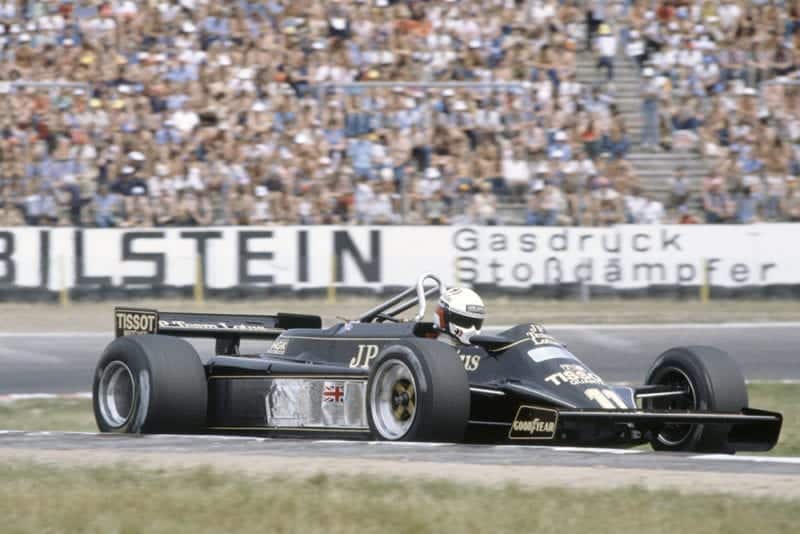
Elio de Angelis in his Lotus 87-Ford Cosworth.
Motorsport Images
In the morning Reutemann’s Williams FW07C/14 had its clutch operation fail, so he finished practice making clutchless gearchanges. During the interval it was found that there was a fluid leak within the oil tank casting through which the operating line runs. As it was a major job to change the oil tank casting, which is situated between the engine and gearbox, the Argentinian had to use the T-car during the timed session. The Renaults were easily fastest, though Alan Jones was in a fighting mood and was right behind them, nobody else being in the same league, well over seven seconds separating the front of the field from the back, with a lap time that was long by today’s standards at an average of 1 min 50 sec, while the average speed was high at more than 226 kph (140 mph). When it was all over three cars were towed in, Watson’s McLaren MP4/3 with a broken engine, Andretti’s Alfa Romeo and Arnoux’s Renault, both having run out of petrol.
Saturday dawned very wet, but by the time testing was due the rain had stopped and the track was drying out. A very big crowd had turned out to watch and the stadium looked less bare. All morning there was rain in the air and skies were grey so that nobody really knew where they were going, undecided as to what tyres and what suspension settings to use and altogether it was a very muddly morning. Villeneuve tried the experimental Ferrari which overnight had turned into a half-B by having a normal rear end fitted to it, but it was little better. Mansell ran out of petrol at the end, the long lap and continuous full throttle work catching a lot of people out on their consumption figures. By 1 pm it was totally dry and quite warm and it could have been an interesting hour of qualifying, but if rubbing-strips were not being replaced, tyres were being conserved or drivers were suffering frustration over the ground-clearance check. The Renaults were still fastest, but this time it was Reutemann who was close behind them and all the fast runners were up there behind them with no surprises as the starting grid took shape. Not at the front at any rate, but down the back the Fittipaldi team were in despair, with neither Rosberg nor Serra qualifying, and Toleman were little better off as neither of their drivers qualified. On the Friday Henton had qualified a certain 24th and looked certain to get in on Saturday but his Hart engine made a nasty noise and he was forced to give up before the hour was over. Jarier was well-placed in mid-field with one of the Osellas, but Gabbiani was left behind and the team had a mixed air about it. Just to keep the record straight de Cesaris crashed his McLaren MP4/1 and Villeneuve had a turbocharger go up in smoke.
Race
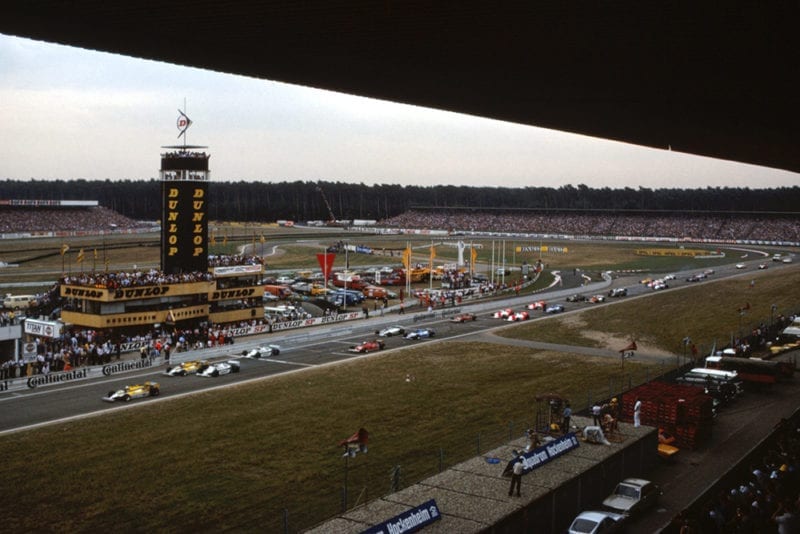
Alain Prost makes a clean getaway on the left side of the track at the start of the race
Motorsport Images
On Sunday it began to look as if the skies would turn blue and that it would get very hot, which would not be good for the turbo-charged cars, but it was not so and soon the sky was concrete coloured and the air became very heavy and sultry. There was half-an-hour warm-up from 12.10 to 12.40 pm during which time Villeneuve spun his Ferrari and wiped off the rear aerofoil, Watson’s No 3 McLaren showed signs of heavy oil consumption and Reutemann’s Williams began misfiring as it had done at Dijon. Jarier’s Osella broke its engine and it was noticed that Piquet’s Brabham had abandoned the carbon-fibre brake discs, but was sticking to 13 inch diameter front Goodyear tyres, whereas the Williams and Lotus teams were using 15 inch. Before the 3 pm start the engine was changed in Reutemann’s car but by the time the change was completed he had opted to take the T-car (number 15) as there was no guarantee that the misfire was not caused by a chassis installation problem. The Osella had a new engine installed and Ferrari straightened out Villeneuve’s car, while Watson opted to race McLaren number two.
Although the standard Hockenheimring grid puts pole-position on the right-hand side, the Renault team requested that Prost should start on the left side of the road. During the parade lap of the 24 cars a few spots of rain fell, but insufficient to cause any sort of flap, though nobody was convinced it was going to stay dry.
It was a good clean start and Reutemann was meteoric, getting between the Renaults as they all swept into the first corner. Out in the country at the far end, Piquet’s left front nose fin sliced into Arnoux’s right-rear tyre and before the end of the opening lap the tyre was in shreds and poor Arnoux was limping back to the pits at the end of the field. It was Prost and Reutemann, already clear of Pironi, Jones, Laffite, Piguet, Villeneuve, Andretti, Tambay, de Cesaris and Watson, with Stohr and Borgudd bringing up the rear. After they had all gone from the stadium Arnoux limped into the pits for a new rear tyre, but damage had been done to the right-hand side pod edge and though he rejoined the race he was totally outclassed. Pironi’s race ended on lap two when his turbo-charged Ferrari engine expired, just when we thought the engines were reliable, and this left Jones in third place.
On lap three Piguet overtook Laffite, while de Cesaris overtook Andretti, and on lap four Salazar was into the pits with smoke pouring from a front brake on the Ensign. On lap five de Cesaris tangled with Tambay and came off second best, ending up off the road with a stalled engine and bent steering tie-rod on the right. On this lap Jones had passed his team-mate to take second place and was attacking the leading Renault, while Reutemann was being attacked by Piguet. Laffite was not really keeping up, but was a long way ahead of the rest of the field which. were lined up behind Villeneuve’s Ferrari, its antics through the stadium corners not encouraging them to get too close. Jones was tight behind the leading Renault for four laps, and looking for a way by, while Piguet found his way past Reutemann on lap nine. Tambay, Rebaque, Patrese, Cheever and Andretti had all got past the wayward Ferrari, but now de Angelis, Daly and Mansell were in an unruly bunch trying to get by.
Completing lap 10 into the stadium Jones was scratching to get by the Renault and got inside it on the left-handed Sachskurve but Prost sat it out with the World Champion, wheel-to-wheel all round the corner with very little air showing between their tyres. This put the Renault at an advantage for the following right-hand curve and Jones was forced to drop back, chastened but unabashed. Nobody thought Alain Prost would be that brave; it was a moment to savour. This slight moment allowed Piguet to get right up with them and for a few laps this trio was nose-to-tail. It was obvious that Prost was not going to relinquish the lead very easily so Jones had to look for a way of out-foxing the little Frenchman, conscious of the blue and white Brabham on his tail.
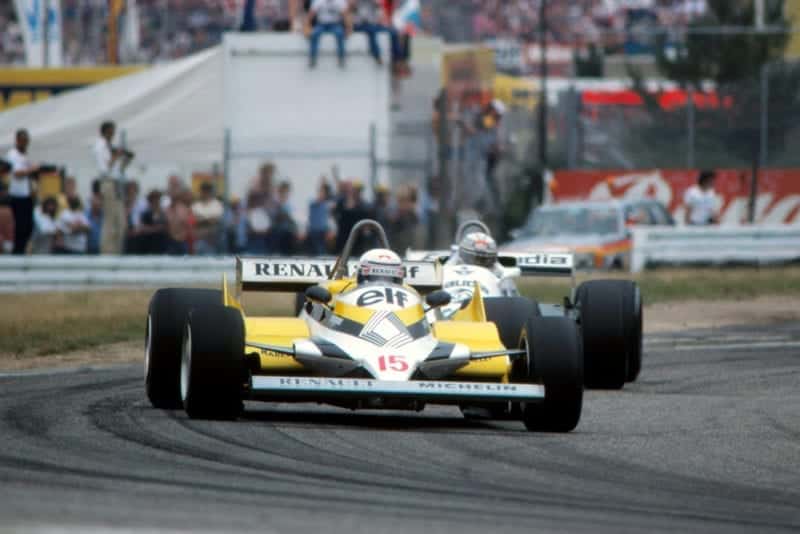
Alain Prost(Renault RE30) leads Alan Jones (Williams FW07C).
Motorsport Images
The scuffling behind Villeneuve ended when Daly and Mansell tangled, the Irishman bringing the March into the pits with a flat right-front tyre, and as subsequently revealed itself, damage to the rear end. Mansell hit the Ferrari up the back and was into the pits at the end of lap 12 with a damaged front aerofoil mounting and Villeneuve came in at the same time for a new set of Michelins. While running in tight formation behind the Renault and the Williams, Piguet suddenly found them swerving one to each side of a piece of metal lying in the road, broken off another car, and he had no option but to run over it. It sliced into the left-hand side pod and rubber edge, which made the handling lop-sided, for already he was minus most of the front nose fin on that side. This allowed Reutemann to regain third place and sit behind Jones while the Brazilian Brabham driver re-adjusted his technique to the changed feel of his car. These four were the only ones in the race, to all intents and purposes, and they were not going all that fast, lapping around 1 min 52 sec against the 1 min 48 sec of practice. There were still some spots of rain in the air and you felt that at any moment a steady drizzle would set in, but it never did.
The second Renault driven by Arnoux was nearly 4 sec a lap slower than the leading French car and by lap 19 Prost was about to lap his team-mate, a situation to which Alan Jones was wide awake. As they all came into the stadium to complete lap 21 the moment came, Prost was forced to go round the outside of Arnoux whereupon Jones pulled his Williams in tight and shot past both of them on the inside. It was one of those manoeuvres of which World Champions are made, and something you do not see at every race, so it was a joy to see it at this one. It was very obvious that Prost had been holding up Jones, for the Williams just pulled away and disappeared, pulling out a 6 sec lead in four laps. Piquet had re-arranged his driving technique to deal with his lop-sided car, and soon hauled in Reutemann and retrieved third place just as the engine in the spare Williams blew up in a big way. Patrese had also disappeared with a blown-up engine in his Arrows, after having an almighty spin inside the stadium on the next-to-last right-hand corner. On this same corner on lap 30 Piquet had a breathless moment when the Brabham ran wide and skated along the verge for a long way before he could get it back on the road, but it did not lose him his third place, for Laffite, in fourth place, was a long way behind. Spots of rain were falling on and off, but insufficient to wet the road, but were no doubt worrying the drivers as they fell on their visors.
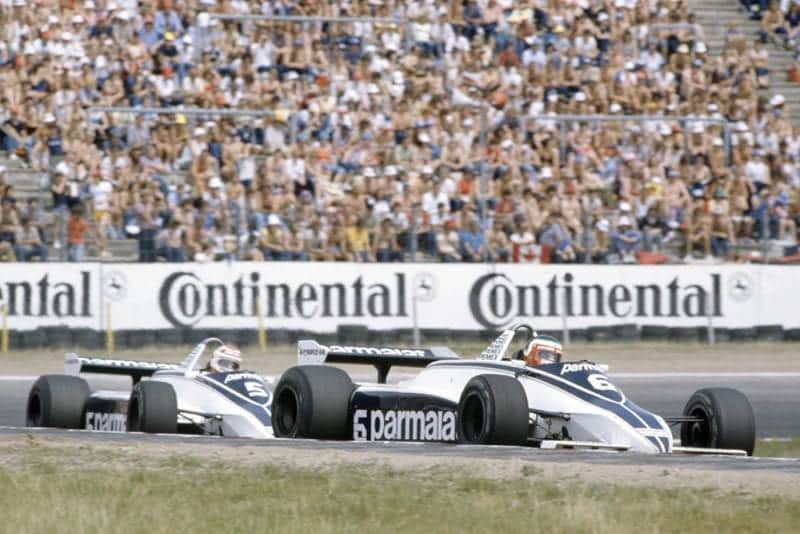
Hector Rebaque secured his best finish of the season with 4th
Motorsport Images
As he completed lap 33 Alan Jones made despairing signs to his pit staff as he went by, and again on lap 35 and on the next lap it was clear what his trouble was. The engine in the Williams was cutting out intermittently, giving a great hiccough as he opened the throttle, either due to air bubbles in the injection system or short-circuits in the electrical system. It sounded as if he was driving switching the ignition on and off! As the power suddenly cut off Jonesey boy’s head would jerk forward, then all 500 bhp would come in with a bang and his head would jerk backwards, all of which must have been straining his neck muscles to the limit, apart from the mental anguish of seeing victory slipping away. Meanwhile, behind him Prost was no happier, for his rev-limiter was playing up and he could not get the permitted rpm, so that the lop-sided Brabham of Piquet was pressing the Renault and got by on lap 37, with only eight laps to go.
Talk about the “walking wounded” and it made you wonder what was wrong with everyone else. Of all the back runners Hector Rebaque had been putting on a spirited show from a very lowly starting-grid position, and had worked his way up to fifth place, ahead of Cheever who was giving the new Tyrrell a good steady run. There was nothing that Jones could do as Piquet closed on him and on lap 39 both the Brabham and the Renault went by the ailing Williams. On lap 42 Jones hiccoughed his way into the pits, where the ignition unit was changed, but to no· avail, and he hiccoughed his way out again having lost third place to Laffite, which was inevitable, and given away places to Rebaque, Cheever, Watson, de Angelis, Jarier and Andretti.
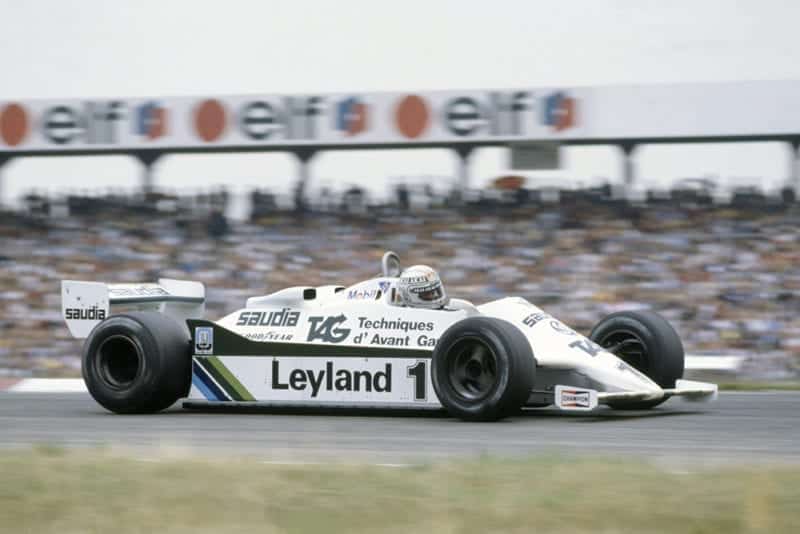
Alan Jones in his Williams FW07C-Ford Cosworth.
Motorsport Images
A very lucky Nelson Piquet reeled off the remaining three laps to finish comfortably ahead of Prost’s Renault, knowing he was lucky to have survived three accidents and still finish first. A long way back came an uninspired Laffite in a Talbot-Matra, his team-mate Tambay having succumbed to yet another broken rear wheel bearing, while the plucky little Rebaque had done another good drive once the race had got under way. Cheever brought a smile to the face of Ken Tyrrell, which does not happen often these days, by bringing the new 011 home fifth and a very disgruntled Watson was sixth, complaining bitterly that his McLaren had been “bouncing” all over the road all the time, this being the car that was perfect at Silverstone. On the very last corner Villeneuve pipped the sick Williams of Alan Jones, and finished 10th instead of 11th, and two corners before the finish poor Marc Surer had a moment’s inattention in the Theodore and stuffed it into the barriers. After a long pit stop to replace a brake caliper Eliseo Salazar drove a consistent race to be still running at the end, but too far back to be classified, and so slow was the pace of the trouble-stricken leaders that he was lapping the Ensign nearly as fast as some of them.
Altogether the whole meeting was rather dull and overcast, like the weather, and no matter if it is a “Max and Bernie Show” or an Automobile Club von Deutschland Show the German Grand Prix is never going to be an epic event while it is held in the confines of the concrete prison camp called the Hockenheim Motodrom. – DSJ.
Notes on the cars at Hockenheimring
Many of the teams had to repair the ravages of the British Grand Prix in the short space between the Silverstone race and the time to set off in the transporters for the German event. Some had to repair damaged cars, or replace them, others had to investigate engine problems or handling problems and modifications had to be made to suit the very high-speed parts of the German Motodrom.
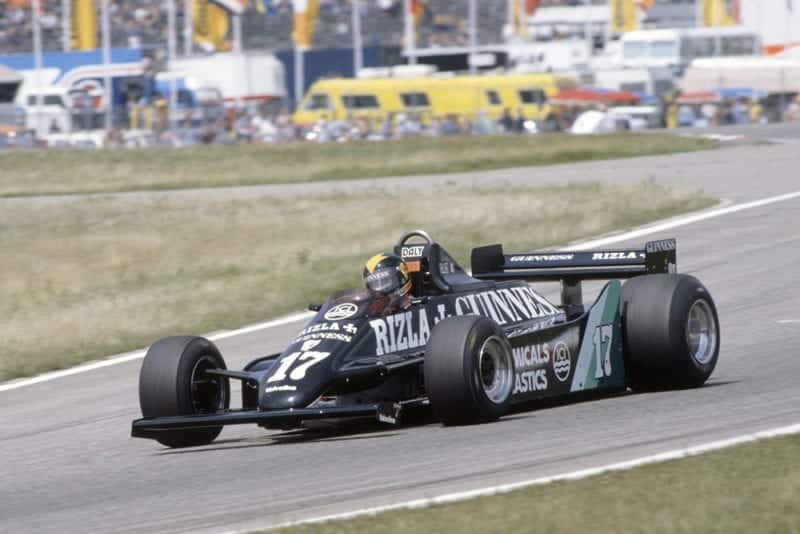
Derek Daly in his March 811-Ford Cosworth.
Motorsport Images
Williams: The car that Alan Jones crashed in his accident with Villeneuve’s Ferrari was FW07C/11, already rebuilt once after its accident at Zolder. It was repairable but rather than rush the job a new one was built up for the German race and this was FW07D/16. It was suffixed D as it was intended to be a new development car and the monocoque was thus labelled, but shortage of time meant that it had to be snatched back and used as the basis for a new car in the C-series. Reutemann had FW07C/14 and these two cars had reshaped side-pods aimed at giving more down-force with less drag. The spare car was FW07C/15 and all three had alternative engine covers which incorporated two large air-collector boxes like “ears” on each side of the crash-bar behind the driver’s head. Investigation into the misfiring that occurred at Monaco and Dijon is being directed to vibrations caused by the rock-hard suspensions, used this season, on the batteries, but no conclusions have yet been reached. For the race Reutemann was forced to use the spare car, number 15, which could not be fitted with the improved side-pods due to attachment differences between the monocoques.
Brabham: Piquet’s crash at Silverstone in BT49C/11 was not as serious as it looked, and the monocoque stood up to the impact remarkably well. However, it was not repaired for Hockenheim and the team-leader had a brand new car, BT49C/14, which was fitted with solid carbon-fibre brake discs to start practice but these were later replaced by normal steel discs, which were retained for the race. The spare car was BT49C/10 which not only had carbon-fibre discs but was equipped with thermocouples to record brake temperatures, with two temperature gauges mounted above the instrument panel, one for Left and one for Right. Rebaque used BT49C/12, his regular car. Just to confuse things the new car that Piquet was driving carried a plate saying it was BT49C/9, but the more important number stamped on the monocoque said that it was 14! There was no sign of the Brabham BT50 with the BMW turbo-charged engine, which was strange being BMW’s own home Grand Prix. It seems they are so lacking in confidence of the engine that they did not want to risk a monumental blow-up in front of the German public.
Renault: The failures at Silverstone in the turbo-charged V6 engines was traced to valve-seat distortions caused by overheating, the overheating being caused by mixture or ignition variations. The team had the same three cars, RE32 (Prost), RE33 (Arnoux) and RE31 the spare, all three still using the central-pillar rear aerofoils as first seen at Silverstone, in place of the long-used rectangular rear aerofoil, which Patrick Head used to describe as a “wind-anchor”.
McLaren: The same three MP4 cars as used at Silverstone were at the German race, except that the aim now was to develop the latest one, MP4/3 normally the spare, into Watson’ race car and retain his Silverstone winning car, MP4/2, as his spare, but to get them so alike that even he would not be able to tell the difference. The much crashed MP4/1 was repaired once again for de Cesaris. As things turned out the engine in No.3 began to use a lot of oil on Sunday morning and Watson had to revert to his Silverstone winning car, No2 for the race.
Lotus: Once more the “twin sprung-structure” Lotus 88B has been laid to rest and the team had three cars in 87 configuration. 87/3 which has always been an 87 was for de Angelis, while 87/4 which had been an 88B but was converted back hastily in the Silverstone paddock had now been assembled more carefully and was for Mansell. The spare car was 87/2. During practice the name ESSEX was blanked out with white tape on the cars, the transporters and the mechanics overalls, presumably because ESSEX Petroleum and Team Lotus were at variance over something or other (like money?). Whatever it was it was settled on Sunday morning and the tape was removed for the race.
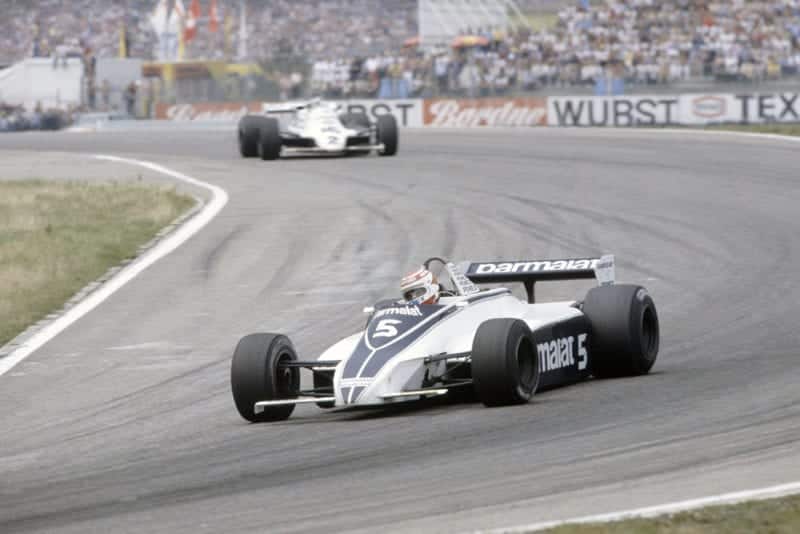
Nelson Piquet (Brabham BT49C-Ford Cosworth) leads Carlos Reutemann (Williams FW07C-Ford Cosworth).
Motorsport Images
Ferrari: The damage to Villeneuve’s car (054) at Silverstone was superficial and it was fully race-worthy once more in time for Hockenheim. Pironi had 053 again, and the experiemental car 051/B was the spare. Apart from having revised front and rear suspension layout the whole front of the monocoque is new and is supposed to be stiffer, but it still does not find favour with either driver. On the second day of practice the entire rear suspension, which uses tubular mounting frames instead of the cast alloy one normally used, was replaced by the standard layout. The front end cannot be altered as it is an integral part of the monocoque, whereas the rear end is bolted on to the engine and gearbox. All three cars were using the alloy spacer between engine and transmission, to give a longer wheelbase and to move the centre of gravity forwards. All three were running with KKK turbo-chargers.
Talbot-Matra: Biggest change in this team was the sacking of the team-manager-cum-technical director Gerard Ducarouge, his dismissal being summary when he returned from Silverstone, though no real explanation was forthcoming. With Jean-Pierre Jabouille being kept on in the team, following his retirement from driving, it was probably felt that his technical knowledge and race knowledge made Ducarouge superfluous. The same three cars were used as at Silverstone, with Tambay’s car (03) uprated to that of the latest car (04) which Laffite uses. There is no real substitute for sheer horse-power on the long Hockenheim fast sections, and horsepower is something that the Matra V12 does not seem to have a surplus of, so the team try to make up by keeping drag as low as possible, but this reduces down-force which handicaps them on fast corners. It is all a matter of “swings and roundabouts” but the Talbot team seem to lose out on both.
Alfa Romeo: Although changes are continually made progress seems to be stationary with the Milanese team, but there was new hope on the horizon as their turbo-charged V8 engine has now been out on test, mounted on the back of a 179 monocoque as a temporary expedient. It is not expected to appear at a race until the Italian GP at Monza. The Hockenheim cars all had the new rear suspension that had been tried on one car at Silverstone. This features a more rigid wishbone layout and a large diameter radius tube fom the top of the upright to the rear bulkhead of the monocoque on each side, which has meant revising the exhaust piping and this has given the cars a sharper exhaust note. There were three cars in the pits, the T-car numbered for Andretti, though it was not used.
Toleman-Hart: The car that Brian Henton crashed in practice at Silverstone was a virtual write-off so he was having to use the original car (TG181/01) which had been brought up to date as far as possible. Warwick was still using the fourth car to be built, and both had the top-mounted AiResearch turbo-chargers on their Hart 415R engines.
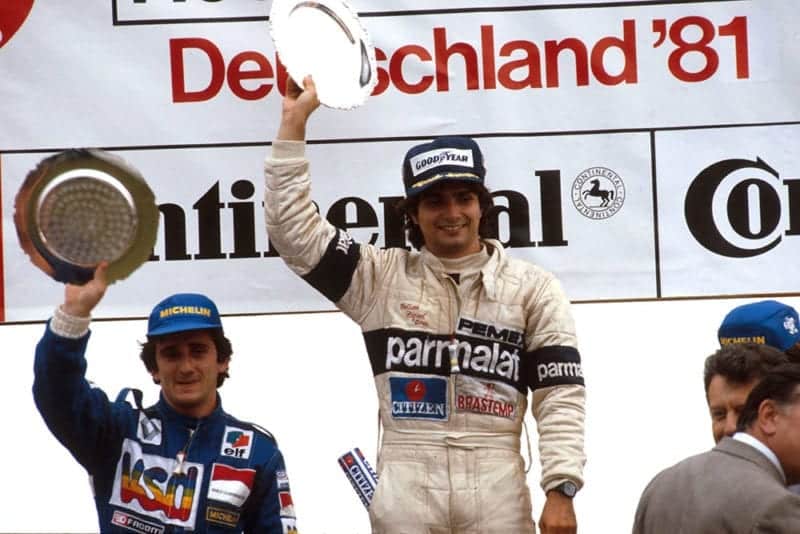
Nelson Piquet (Brabham Ford) 1st position and Alain Prost (Equipe Renault) 2nd position on the podium.
Motorsport Images
Tyrrell: The new car 011/1 which was damaged in the practice accident at Silverstone by Cheever, was repaired and made its race debut at Hockenheim. Two of the old 010 cars were also taken along, one for Alboreto and the other as a spare car.
Arrows: Siegfried Stohr’s crashed car at Silverstone was a virtual write-off and the team had to build up another car for him. The remaining teams of ATS, Ensign, March, Fittipaldi, Osella and Theodore were not radically changed, though Ensign had a spare monocoque in their transporter in case of disaster. – DSJ.
